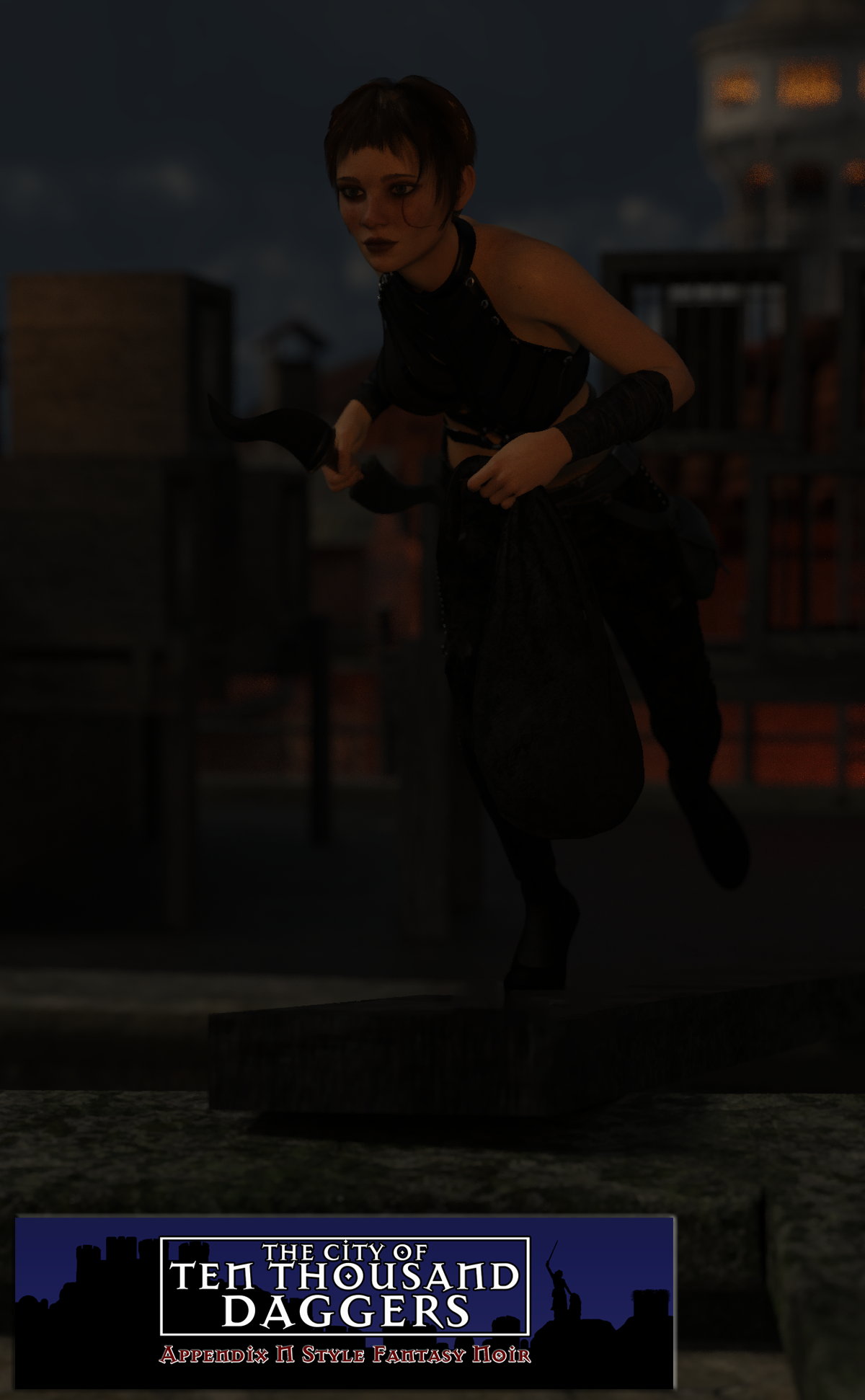Rooftop Highway
"You grew up in the city, so you've heard stories about the Rooftop Highway, probably looked out the window at night trying to catch a glimpse of someone making off with their loot. Hell, you may even think you've travelled it yourself. That's why I brung you up here today. We're going to be using it when we leave Molok the Moneylenders' tomorrow night, and I need to make sure your head's not full of nonsense that'll get the both of us killed. Now, this roof in particular isn't one we're likely to visit tomorrow, but I brung you here first because it's got some qualities that make a few things easier to explain. Let's say for the sake of argument that we just jumped across the gap from that insula over there and landed here on this roof. Take a look around and see if you can guess where we'd go next while an old man talks. "Now the biggest misunderstanding about the Thieves' Road is that being able to travel it comes down to athletic ability, quick thinking, and no small amount of fearlessness. You've no doubt heard the stories about Lady Tolva or the Prince of Shadows leaping down to a rooftop with guards or chimeric watchbeasts or demons or what have you right on their heels. They take a quick look around, see their next move--usually a daft one--and take some death-defying leap, trusting in fate to protect them. It makes for a good story, but it also makes for a good way to end up dead or crippled in a pile of your own blood and entrails on the cobblestones below. "Have you found our next move? Ah, the clothesline. Had a feeling you might choose that one. Looks like a solid route, donnit? Just one problem you're going to run into. If you look across the alley to the other side, you'll see the opposite pully's got an anchor that's coming out of the wall. Slight little fella like you might make it across without pulling it out, but my best case is that I end up hanging from the rope a few floors down. Now you wouldn't see that in the dark, and I for one wouldn't have noticed in the daylight if I hadn't knowed to look for it. Now, as for how I knew to look for it: See that "X" that's been scratched into the rust on the pulley on this side? That's a trail sign, just like woodsmen make on trees, and it lets us know that the clothesline ain't a safe bet. Now you might not notice that at night either, especially if you're being chased or have your head full of ideas about how to spend your loot. That's why any trip along a section of the rooftop highway you don't know like the back of your hand needs to be planned and scouted ahead of time, preferably when there's plenty of light so you can see the signs left for you by those who've gone before."--Ond Graycloak, Master Thief
They say that a person with enough agility, resourcefulness, and nerve can travel from the River Gate to Stinktown without ever setting foot on solid ground. The Rooftop Highway is a method of travel by which one moves from building to building in a daredevil series of leaps, swings, and other feats of athletic ability. A typical section of "road" may involve leaping from a rooftop to a balcony across the street, shimmying up a drainpipe, swinging hand-over-hand along a clothesline, lassoing some convenient piece of architecture, swinging across a wide street or courtyard, climbing the rope to the top, then lowering oneself down a series of ledges until they're low enough to jump into a hay cart on the street below.
Travel along the Rooftop Highway began during the time of the Dragon Kings, when thieves used it to avoid being spotted by guards and anyone else who happened to be out on the streets when they were making their way to or from a job. Even though many of the sections of the city where the Thieves' Road (as it is also called) is best developed no longer have an organized guard, this method of travel is still widely used by criminals and others who don't want others to note their comings and goings.
Although most people think of travel along the Rooftop Highway as a death-defying series of snap judgements and risky maneuvers, in reality most trips either follow well-known paths or are carefully planned ahead of time. Those who frequent the streets above the streets have a well-developed series of "trail markings" that can reveal the best path to those who know how to read them. In addition to information about the route, these markers often also reveal who controls a particular block, which buildings to avoid due to aggressive inhabitants, loud animals, or other dangers, and whether the next building along the highway is a "dead end" with no safe routes to anywhere but the street below. Some of the symbols are made by thieves as they hunker down hiding from pursuers or stop to catch their breath after a particularly intense bit of acrobatics, but most are maintained by travelers who frequently use a particular section of "road."
Alternate Names
Thieves' Road, The Streets Above The Streets, Fool's Road
Thieves' Road, The Streets Above The Streets, Fool's Road






Comments